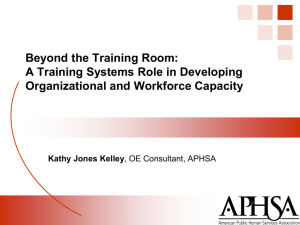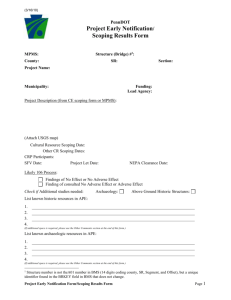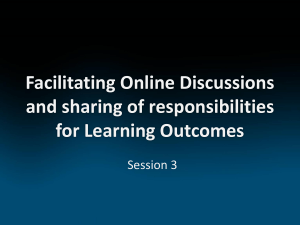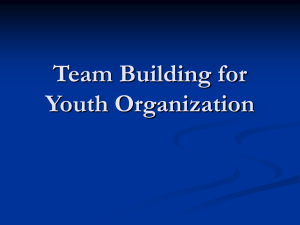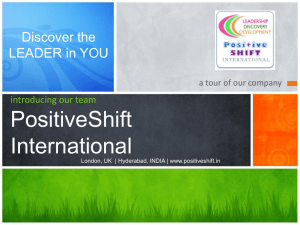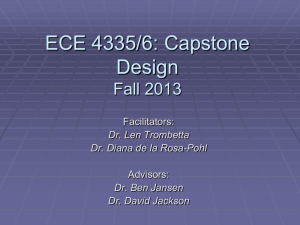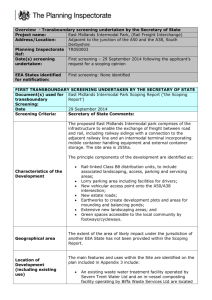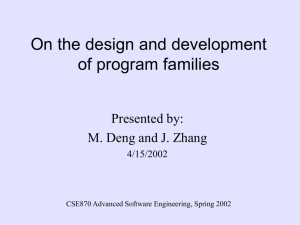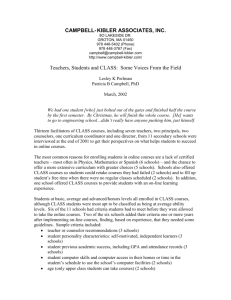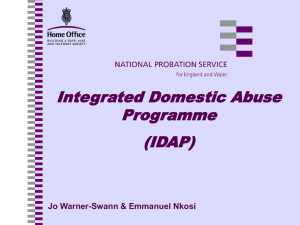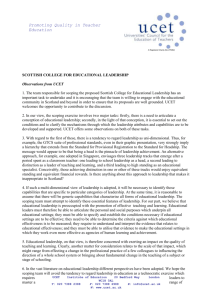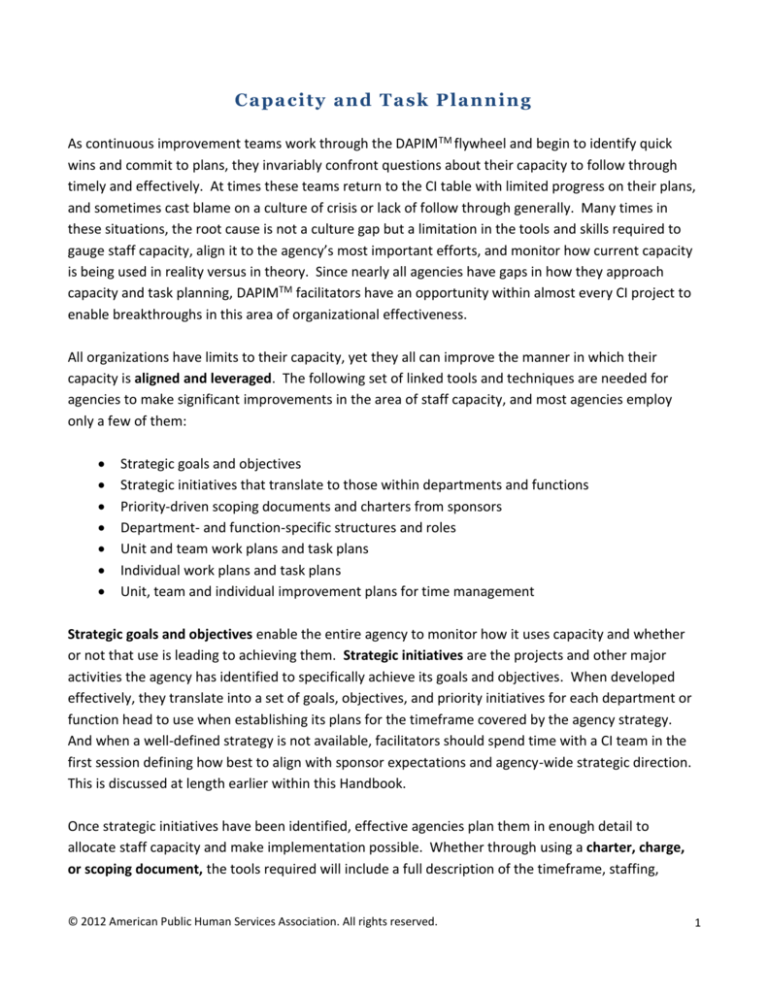
C a p a cit y a n d T a s k P la n n in g
As continuous improvement teams work through the DAPIM TM flywheel and begin to identify quick
wins and commit to plans, they invariably confront questions about their capacity to follow through
timely and effectively. At times these teams return to the CI table with limited progress on their plans,
and sometimes cast blame on a culture of crisis or lack of follow through generally. Many times in
these situations, the root cause is not a culture gap but a limitation in the tools and skills required to
gauge staff capacity, align it to the agency’s most important efforts, and monitor how current capacity
is being used in reality versus in theory. Since nearly all agencies have gaps in how they approach
capacity and task planning, DAPIMTM facilitators have an opportunity within almost every CI project to
enable breakthroughs in this area of organizational effectiveness.
All organizations have limits to their capacity, yet they all can improve the manner in which their
capacity is aligned and leveraged. The following set of linked tools and techniques are needed for
agencies to make significant improvements in the area of staff capacity, and most agencies employ
only a few of them:
Strategic goals and objectives
Strategic initiatives that translate to those within departments and functions
Priority-driven scoping documents and charters from sponsors
Department- and function-specific structures and roles
Unit and team work plans and task plans
Individual work plans and task plans
Unit, team and individual improvement plans for time management
Strategic goals and objectives enable the entire agency to monitor how it uses capacity and whether
or not that use is leading to achieving them. Strategic initiatives are the projects and other major
activities the agency has identified to specifically achieve its goals and objectives. When developed
effectively, they translate into a set of goals, objectives, and priority initiatives for each department or
function head to use when establishing its plans for the timeframe covered by the agency strategy.
And when a well-defined strategy is not available, facilitators should spend time with a CI team in the
first session defining how best to align with sponsor expectations and agency-wide strategic direction.
This is discussed at length earlier within this Handbook.
Once strategic initiatives have been identified, effective agencies plan them in enough detail to
allocate staff capacity and make implementation possible. Whether through using a charter, charge,
or scoping document, the tools required will include a full description of the timeframe, staffing,
© 2012 American Public Human Services Association. All rights reserved.
1
project leadership, and general amount of time required (either as a percentage of a position’s overall
time or as a number of work days by role). An example of such as scoping document is attached, and a
Chartering Template can be found in the Chapter Two Appendix.
Since all organizations are operated on a daily basis through chains-of-command organized around
departments, regions, and/or functions, the agency’s priority initiatives need to shape the overall
structure and roles of such units for the required capacity to be allocated in reality versus in theory.
Unit structures and roles should be made adaptable enough to form teams within and between them
to accomplish strategic priorities across silos. In fact, role descriptions can and should be developed
with this very adaptability in mind (see the attached example for APHSA’s OE Consultants). And as
discussed in this Handbook’s Chapter One, roles at different levels of the organizational structure
should be developed for the general type of work at that level.
When aligning their structures and roles, unit leads can reflect on the way in which their teams evolve
their capacity and add greater value to the agency as a whole over time. This is especially important
for support functions such as HR, IT, Communications and Finance (see APHSA’s Building OE Capacity
Guidebook). In a common continuous improvement scenario, a support function will first deliver more
effectively the expected and traditional services. It will then shift its capacity (e.g., through
automation, client self help, staff skill-building and streamlining administration) towards providing
more innovative tactical support in developing key processes. As the organization learns how to use
the key processes most effectively, this shift will be followed by a further shift in capacity toward
helping improve the organization’s structure and culture through leadership influence. Finally, support
functions with the greatest value-add shift their capacity further toward helping strengthen the
organization’s overall strategy.
Once unit structures and roles have been adapted as needed to the agency’s strategic priorities,
scoping documents and role descriptions can be translated into unit- and individual-specific work
plans. The related work planning tool should include both prototypical targets for how time should be
spent within the unit overall, as well as specific allocations of time by individual within the unit. An
important rule of thumb for facilitators to use when helping teams develop their first work plans is
that, in general, an individual can track about 50 productive work days for every three calendar
months. This allows for absences and leaves, as well as normal levels of downtime and housekeeping
(e.g., reading and responding to less important email). Applying this rule of thumb ensures that work
plans will be realistic as time unfolds. See the attached examples of a unit work plan and an individual
work plan for the APHSA OE team.
Once unit and individual work plans have been established, unit and individual task planning can be
accomplished. Effective task plans, otherwise known as action plans, break more general areas of
© 2012 American Public Human Services Association. All rights reserved.
2
work into systematic steps and timeframes, with specific individuals or groups assigned responsibility
for each task/action step (see this Handbook’s Chapter Two Appendix for a related template). Unit
task plans, where everyone’s individual task plans are combined on the same chart, enable unit leads
to evaluate how they might shift capacity and therefore task accountability amongst unit members to
avoid lapses and compression issues, to help the team reflect on how best to divide and conquer the
work at hand versus having too many staff involved, and to identify developmental opportunities for
team members as their potential unfolds (e.g., teaming a junior and senior unit member up in a task or
project area).
The final element in the array that make up effective capacity and task planning can be viewed as the
“M” in a related mini- DAPIMTM - continuous improvement efforts regarding time management. Time
management has its own section within this Chapter Four Appendix. But to summarize, facilitators
who are helping teams advance here should guide them to compare how they actually use their time
to how it “should” be used as reflected in unit and individual work plans. The root causes for the gaps
may include ineffectively used or ignored elements of the planning approach discussed above, or they
may relate to capacity-related issues that can be addressed in other ways, such as through skillbuilding, additional tools, or key process improvements.
One additional theme for DAPIMTM facilitators to note here is that each of these capacity and task
planning elements is iterative. This means that advancements or changes in any one element will likely
result in a related change or improvement in another. Just as evolving strategy would impact every
element that follows from it, an evolving understanding of staff capacity will result in adjustments to
the timing and prioritization of various agency priorities and initiatives (e.g., investments in staff
development or technology designed to automate or streamline operations).
Facilitators will encounter continuous improvement teams at varying stages of readiness for the full
scope of this topic. Your CI team may begin this work in a limited area, such as role clarity or unit work
plans, and expand its understanding and readiness to tackle the full range of this improvement work
over time.
© 2012 American Public Human Services Association. All rights reserved.
3
Team Activity: Capacity and Task Planning
Here’s how a facilitator might work with a continuous improvement team to help it establish an
effective approach to capacity and task planning:
1. Review the APHSA tools for capacity and task planning in general. Discuss as a group what
really “stuck”.
2. Identify whether or not the team has clear direction on what its strategic priorities are, and
what related goals, objectives and initiatives are in place. If they are not in place, plan with the
team how to get this clarity from higher in its chain-of-command or from its stakeholders.
3. Brainstorm and define how the unit, function or team should be structured and how its roles
should be defined. This discussion should relate directly back to strategic goals, objectives and
initiatives.
4. Compare the current tools and methods employed for capacity and task planning with the ones
recommended in this guidance:
Scoping documents and charters
Unit/team and individual work plans
Unit/team and individual task plans
Time management continuous improvement efforts
Some CI teams will prefer to start this conversation from the time management perspective,
especially those who do not use any form of work and task planning.
5. Identify related strengths and gaps, and the root causes for those gaps. If the root causes
relate more to cultural resistance or non-constructive resistance to using capacity planning
tools, then consider using the guidance for Follow Through, Organizational Empowerment,
Monitoring, Trust and Aim, or Power and Resistance.
6. If the root causes relate to a lack of capacity planning tools, determine how to best sequence
adding these tools to your work. For example, scoping tools may need to precede work plan
tools for them to be effective.
© 2012 American Public Human Services Association. All rights reserved.
4
7. Determine which tools to design or borrow (e.g., from examples provided in these materials)
and make related commitments for using them.
8. Determine how best to track your plan progress and the impact on aligning and leveraging staff
capacity. Determine how you will make ongoing adjustments to your tools and plans for them
as needed.
© 2012 American Public Human Services Association. All rights reserved.
5

